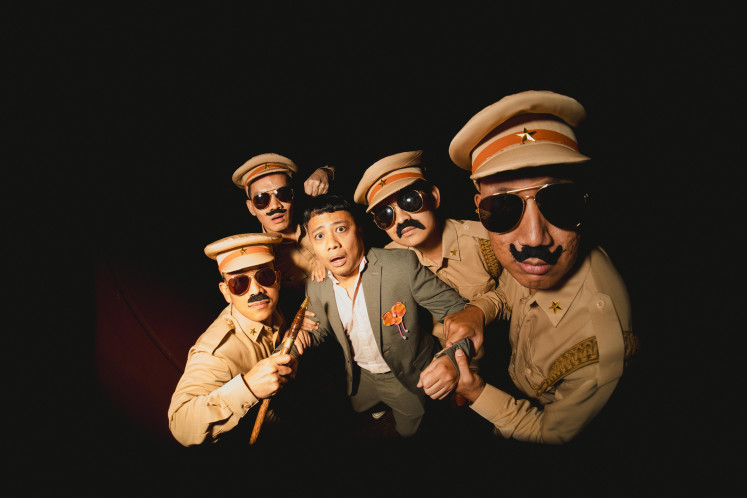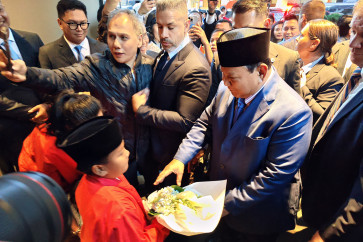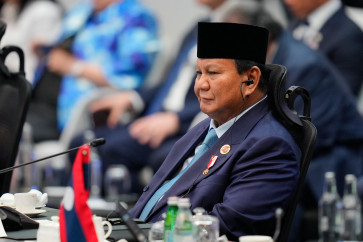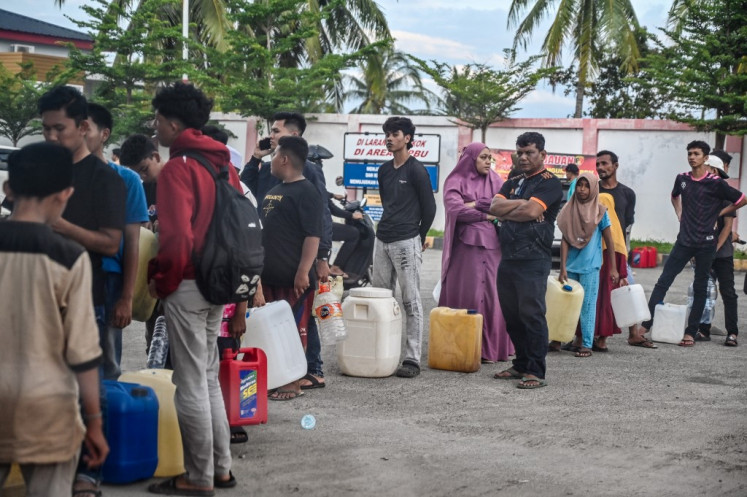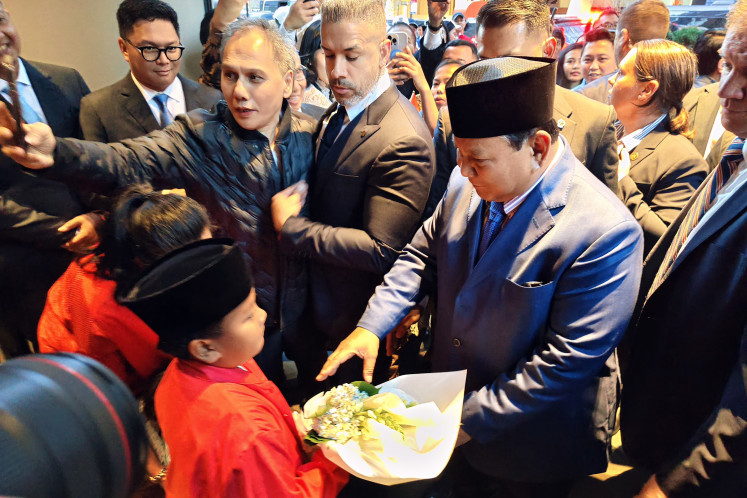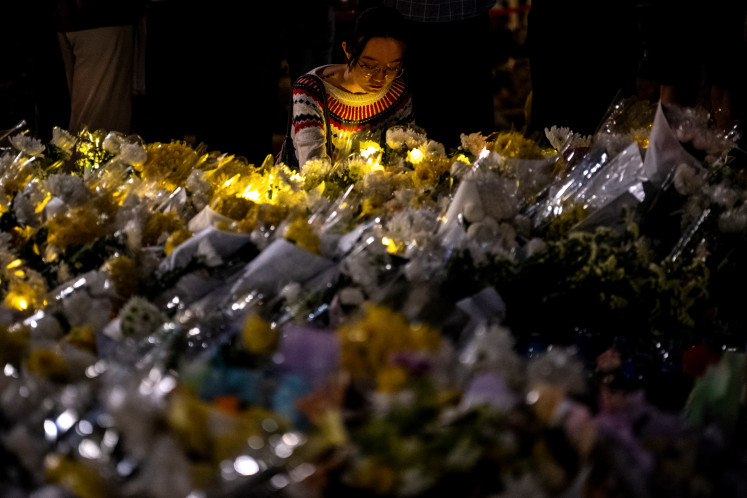Popular Reads
Top Results
Can't find what you're looking for?
View all search resultsPopular Reads
Top Results
Can't find what you're looking for?
View all search resultsSukarno's vision of a modern capital
Jl
Change text size
Gift Premium Articles
to Anyone
![Jl. Thamrin Publisher: Unknown. Mid 1960s.(Courtesy of Scott Merrillees)" border="0" height="331" width="510"><span class="caption"><strong>Jl. Thamrin </strong>Publisher: Unknown. Mid 1960s.(Courtesy of Scott Merrillees)</span></span></p><p>In 1958, a young Indonesia was awarded the hosting rights of the 1962 Asian Games and had just finalized a war reparation agreement with Japan worth over US$220 million.</p><p>The two events propelled the countryâs first president Sukarno to realize his vision of a modern, grand Jakarta that would become a beacon for emerging nations around the world. <br><br>Having trained as an engineer and worked briefly as an architect, Sukarno changed the face of the former colonial backwater by erecting new buildings, wide thoroughfares and, most importantly, monuments to proclaim the grandeur of the newly independent country. <br><br>Workers toiled around the clock and building materials were requisitioned to complete the ambitious projects. It was an astonishing achievement for the infant republic. <br><br>After arriving at Kemayoran Airport, Games contingents were driven along the revamped Jl. Jendral Sudirman and Jl. Thamrin, greeted by statues of a young man and woman waving from atop a tall pedestal â the Tugu Selamat Datang (Welcome Monument). <br><br>The athletes stayed at Hotel Indonesia, an icon of modernity and competed at the brand new Gelora Bung Karno sports complex.<br><br>The monumental transformation of Jakarta has been retold by Scott Merrillees in his collection of 187 postcards, <em>Jakarta: Portraits of a Capital 1950 â 1980 â</em> his third book. </p><p><span class="inline inline-center"><img class="image image-_original " src="http://202.158.21.182/files/images2/21jakarta.jpg" border="0" height="280" width="350"></span><br><br>Born in 1962 in Melbourne, Australia, Merrillees worked in Jakarta for 22 years, mainly in the finance sector. <br><br>Mesmerized by Jakarta, he learned the capitalâs history and collected photos of its evolving physical landscape, resulting in his first book, <em>Batavia in Nineteenth Century Photographs</em>, which was published in 2000. <br><br>He went on to use old postcards depicting Jakarta in the last decades of the colonial era in <em>Jakarta: Postcards of a Capital 1900-1950. </em><br><br>âI chose postcards because they are a fairly complete medium to show Jakarta in the 1900s,â he said at the bookâs recent launch in Jakarta. <br><br>In his latest work, Merrillees takes readers back to Jakarta in 1950, when many citizens took trams to reach the bustling Pasar Senen and residents of Jl. Hayam Wuruk did their daily laundry in the canal. <br><br>âJakarta had a tramway system for almost a hundred years, from 1869 to 1962. It was very cheap, popular and crisscrossed large parts of the city,â Merrillees said.<br><br>Jakartaâs finest hotel at the time, the Hotel des Indes, still stood proudly on Jl. Gajah Mada, as an elite venue for dignitaries. <br><br>In the courtyard of the Gedung Proklamasi (Proclamation Building) on Jl. Pegangsaan Timur, where Sukarno proclaimed Indonesiaâs independence in 1945, several womenâs groups erected a small monument to commemorate the first anniversary of Indonesiaâs independence. </p><p><span class="inline inline-center"><img class="image image-_original " src="http://202.158.21.182/files/images2/21scot.jpg" alt="Scott Merrillees. (Courtesy of Scott Merrillees)" title="Scott Merrillees. (Courtesy of Scott Merrillees)" border="0" height="452" width="341"><span class="caption"><strong>Scott Merrillees.</strong> (Courtesy of Scott Merrillees)</span></span><br><br>âUnfortunately, the Proclamation Building has gone. The monument was also demolished and replaced.â <br><br>Many young Indonesians may not realize that the Harmoni area was named after De Harmonie, also known as the Harmonie Club, on Jl. Majapahit, opened by the British lieutenant-governor of Java, Thomas Stamford Raffles, in 1815. The famous social club existed for 170 years until it was demolished in 1985 as part of a road-widening project. <br><br>Kemayoran Airport was in its golden years in 1958, and a center of attraction for journalists. <br><br>âRestaurants at Kemayoran [airport] were not like ordinary restaurants because journalists used to wait there in the 50s. It was the only airport, so if you wanted to get any celebrity, Bung Karno, Bung Hatta or any politician coming through, you knew they were going to arrive in Kemayoran.â<br><br>Back then, most Jakartans considered the Kebayoran Baru area of South Jakarta remote. <br><br>âCivil servants were given a chance to buy houses in Kebayoran Baru, but they were not happy with that. They felt like they were being thrown away beyond the borders of Jakarta.â <br><br>âLook at Kebayoran Baru now, together with Menteng, it has the most valuable real estate in the city, worth a fortune, [it costs] millions of dollars to buy a place there.â </p><p>Reshaping a capital is an unusual project for a head of state to busy himself with. But Sukarnoâs architectural knowledge, his charisma and the political transition to Guided Democracy from 1957 to 1959, gave the first president the power to implement his vision.<br><br>The governmentâs acquisition of Dutch assets in 1957 and Japanâs war reparations in 1958 were also determining factors. <br><br>âHe didnât want to just accept the colonial capital. He wanted to build a new capital. And he wanted to rebuild the capital for several purposes. Obviously, one, for the people of Jakarta themselves. It was to be a city built by Indonesians for Indonesians.â <br><br>âBung Karno wanted Jakarta to be a beacon of hope to inspire the developing world and for Indonesia to be one of leaders of the developing worldâ.</p><p><span class="inline inline-center"><img class="image image-_original " src="http://202.158.21.182/files/images2/21thegrandcinema_0.jpg" alt="Jakartaâs Tramways. Publisher: Tarzan Photo. Dated April 6, 1953. (Courtesy of Scott Merrillees)" title="Jakartaâs Tramways. Publisher: Tarzan Photo. Dated April 6, 1953. (Courtesy of Scott Merrillees)" border="0" height="331" width="512"><span class="caption"><strong>Jakartaâs Tramways.</strong> Publisher: Tarzan Photo. Dated April 6, 1953. (Courtesy of Scott Merrillees)</span></span><br><br>The Games paved the way for Sukarno to speed up the construction of Hotel Indonesia, which later became the heart of the cityâs elite social life. <br><br>âIt was a social center of Jakarta in the 1960s and much of the 1970s. Bung Karno often came here in the first part of the 1960s with Dewi Sukarno for entertainment,â said Merrillees, referring to one of Sukarnoâs wives. <br><br>Sarinah shopping center, named after Sukarnoâs beloved childhood nanny, was the countryâs first mall and part of the presidentâs failed attempt to stabilize retail prices.<br><br>âHis view was that if the government owned one big department store, the prices at Sarinah would set the highest level throughout the rest of the country. Of course, it was not possible to do that.â <br><br>In the aftermath of the 1965 purge and transition of power to Soeharto, the construction projects initiated by Sukarno were put on hold for some years. <br><br>Jakarta governor Ali Sadikin, who served from 1966 to 1977, played an important role in continuing the projects under the Soeharto administration. </p><p>âSeveral initiatives were started by Bung Karno and completed by <em>Pak</em> Harto, such as Hotel Borobudur, Gedung Veteran and Wisma Nusantara. The building of the Conferences of the New Emerging Forces (CONEFO)was initiated by Bung Karno but completed and officiated by <em>Pak </em>Harto as the House of Representatives building.â <br><br>The book ends in 1970 with postcards showing midday traffic congestion on Jl. Thamrin and Jl. Hayam Wuruk â embryos of todayâs infamous congestion. <br><br>Despite losing some historic buildings, such as the Proklamasi Building and the Hotel des Indes, Jakarta gained many iconic landmarks between 1950 and1980, from monuments â the National Monument, the Irian Jaya Liberation Monument â and buildings â Hotel Indonesia, the Istiqlal Mosque to Taman Ismail Marzuki planetarium and Taman Impian Jaya Ancol recreation center. <br><br>After writing three books that recount the transformation of the cityâs landscape, Merrillees said he was not interested in continuing Jakartaâs story from the 1980s on. <br><br>âIt is too modern. Let the next generation of historians write that. If my wife allows, and I am willing to make the fourth book, I will go back to the 19th century.â<br><br>Merrillees, who has been a guest speaker of historical tours initiated by the Sahabat Museum community, said he hoped that his books could serve as a time machine for future generations in the ever-changing Jakarta. <br><br>âI hope it can be used to show the next generation to see Jakarta in the past, because every year we see old buildings being demolished despite their heritage status.â</p><p><span class="inline inline-center"><img class="image image-_original " src="http://202.158.21.182/files/images2/jakartafair.jpg" alt="Jakarta Fair. Publisher: Probably Tan Tat Hin. Year: 1953. (Courtesy of Scott Merrillees)" title="Jakarta Fair. Publisher: Probably Tan Tat Hin. Year: 1953. (Courtesy of Scott Merrillees)" border="0" height="324" width="512"><span class="caption"><strong>Jakarta Fair.</strong> Publisher: Probably Tan Tat Hin. Year: 1953. (Courtesy of Scott Merrillees)</span></span></p><p><span class="inline inline-center"><img class="image image-img_assist_custom-511x320 " src="http://202.158.21.182/files/images2/21grand.img_assist_custom-511x320.jpg" alt="The Grand Cinema. Publisher: Unknown. Year: 1953. (Courtesy of Scott Merrillees)" title="The Grand Cinema. Publisher: Unknown. Year: 1953. (Courtesy of Scott Merrillees)](https://www.thejakartapost.com/files/images2/21jlthamrin_0.img_assist_custom-512x331.jpg) Jl. Thamrin Publisher: Unknown. Mid 1960s.(Courtesy of Scott Merrillees)" border="0" height="331" width="510">Jl. Thamrin Publisher: Unknown. Mid 1960s.(Courtesy of Scott Merrillees)
Jl. Thamrin Publisher: Unknown. Mid 1960s.(Courtesy of Scott Merrillees)" border="0" height="331" width="510">Jl. Thamrin Publisher: Unknown. Mid 1960s.(Courtesy of Scott Merrillees)In 1958, a young Indonesia was awarded the hosting rights of the 1962 Asian Games and had just finalized a war reparation agreement with Japan worth over US$220 million.
The two events propelled the countryâs first president Sukarno to realize his vision of a modern, grand Jakarta that would become a beacon for emerging nations around the world.
Having trained as an engineer and worked briefly as an architect, Sukarno changed the face of the former colonial backwater by erecting new buildings, wide thoroughfares and, most importantly, monuments to proclaim the grandeur of the newly independent country.
Workers toiled around the clock and building materials were requisitioned to complete the ambitious projects. It was an astonishing achievement for the infant republic.
After arriving at Kemayoran Airport, Games contingents were driven along the revamped Jl. Jendral Sudirman and Jl. Thamrin, greeted by statues of a young man and woman waving from atop a tall pedestal â the Tugu Selamat Datang (Welcome Monument).
The athletes stayed at Hotel Indonesia, an icon of modernity and competed at the brand new Gelora Bung Karno sports complex.
The monumental transformation of Jakarta has been retold by Scott Merrillees in his collection of 187 postcards, Jakarta: Portraits of a Capital 1950 â 1980 â his third book.

Born in 1962 in Melbourne, Australia, Merrillees worked in Jakarta for 22 years, mainly in the finance sector.
Mesmerized by Jakarta, he learned the capitalâs history and collected photos of its evolving physical landscape, resulting in his first book, Batavia in Nineteenth Century Photographs, which was published in 2000.
He went on to use old postcards depicting Jakarta in the last decades of the colonial era in Jakarta: Postcards of a Capital 1900-1950.
âI chose postcards because they are a fairly complete medium to show Jakarta in the 1900s,â he said at the bookâs recent launch in Jakarta.
In his latest work, Merrillees takes readers back to Jakarta in 1950, when many citizens took trams to reach the bustling Pasar Senen and residents of Jl. Hayam Wuruk did their daily laundry in the canal.
âJakarta had a tramway system for almost a hundred years, from 1869 to 1962. It was very cheap, popular and crisscrossed large parts of the city,â Merrillees said.
Jakartaâs finest hotel at the time, the Hotel des Indes, still stood proudly on Jl. Gajah Mada, as an elite venue for dignitaries.
In the courtyard of the Gedung Proklamasi (Proclamation Building) on Jl. Pegangsaan Timur, where Sukarno proclaimed Indonesiaâs independence in 1945, several womenâs groups erected a small monument to commemorate the first anniversary of Indonesiaâs independence.
 Scott Merrillees. (Courtesy of Scott Merrillees)
Scott Merrillees. (Courtesy of Scott Merrillees)
âUnfortunately, the Proclamation Building has gone. The monument was also demolished and replaced.â
Many young Indonesians may not realize that the Harmoni area was named after De Harmonie, also known as the Harmonie Club, on Jl. Majapahit, opened by the British lieutenant-governor of Java, Thomas Stamford Raffles, in 1815. The famous social club existed for 170 years until it was demolished in 1985 as part of a road-widening project.
Kemayoran Airport was in its golden years in 1958, and a center of attraction for journalists.
âRestaurants at Kemayoran [airport] were not like ordinary restaurants because journalists used to wait there in the 50s. It was the only airport, so if you wanted to get any celebrity, Bung Karno, Bung Hatta or any politician coming through, you knew they were going to arrive in Kemayoran.â
Back then, most Jakartans considered the Kebayoran Baru area of South Jakarta remote.
âCivil servants were given a chance to buy houses in Kebayoran Baru, but they were not happy with that. They felt like they were being thrown away beyond the borders of Jakarta.â
âLook at Kebayoran Baru now, together with Menteng, it has the most valuable real estate in the city, worth a fortune, [it costs] millions of dollars to buy a place there.â
Reshaping a capital is an unusual project for a head of state to busy himself with. But Sukarnoâs architectural knowledge, his charisma and the political transition to Guided Democracy from 1957 to 1959, gave the first president the power to implement his vision.
The governmentâs acquisition of Dutch assets in 1957 and Japanâs war reparations in 1958 were also determining factors.
âHe didnât want to just accept the colonial capital. He wanted to build a new capital. And he wanted to rebuild the capital for several purposes. Obviously, one, for the people of Jakarta themselves. It was to be a city built by Indonesians for Indonesians.â
âBung Karno wanted Jakarta to be a beacon of hope to inspire the developing world and for Indonesia to be one of leaders of the developing worldâ.
 Jakartaâs Tramways. Publisher: Tarzan Photo. Dated April 6, 1953. (Courtesy of Scott Merrillees)
Jakartaâs Tramways. Publisher: Tarzan Photo. Dated April 6, 1953. (Courtesy of Scott Merrillees)
The Games paved the way for Sukarno to speed up the construction of Hotel Indonesia, which later became the heart of the cityâs elite social life.
âIt was a social center of Jakarta in the 1960s and much of the 1970s. Bung Karno often came here in the first part of the 1960s with Dewi Sukarno for entertainment,â said Merrillees, referring to one of Sukarnoâs wives.
Sarinah shopping center, named after Sukarnoâs beloved childhood nanny, was the countryâs first mall and part of the presidentâs failed attempt to stabilize retail prices.
âHis view was that if the government owned one big department store, the prices at Sarinah would set the highest level throughout the rest of the country. Of course, it was not possible to do that.â
In the aftermath of the 1965 purge and transition of power to Soeharto, the construction projects initiated by Sukarno were put on hold for some years.
Jakarta governor Ali Sadikin, who served from 1966 to 1977, played an important role in continuing the projects under the Soeharto administration.
âSeveral initiatives were started by Bung Karno and completed by Pak Harto, such as Hotel Borobudur, Gedung Veteran and Wisma Nusantara. The building of the Conferences of the New Emerging Forces (CONEFO)was initiated by Bung Karno but completed and officiated by Pak Harto as the House of Representatives building.â
The book ends in 1970 with postcards showing midday traffic congestion on Jl. Thamrin and Jl. Hayam Wuruk â embryos of todayâs infamous congestion.
Despite losing some historic buildings, such as the Proklamasi Building and the Hotel des Indes, Jakarta gained many iconic landmarks between 1950 and1980, from monuments â the National Monument, the Irian Jaya Liberation Monument â and buildings â Hotel Indonesia, the Istiqlal Mosque to Taman Ismail Marzuki planetarium and Taman Impian Jaya Ancol recreation center.
After writing three books that recount the transformation of the cityâs landscape, Merrillees said he was not interested in continuing Jakartaâs story from the 1980s on.
âIt is too modern. Let the next generation of historians write that. If my wife allows, and I am willing to make the fourth book, I will go back to the 19th century.â
Merrillees, who has been a guest speaker of historical tours initiated by the Sahabat Museum community, said he hoped that his books could serve as a time machine for future generations in the ever-changing Jakarta.
âI hope it can be used to show the next generation to see Jakarta in the past, because every year we see old buildings being demolished despite their heritage status.â
 Jakarta Fair. Publisher: Probably Tan Tat Hin. Year: 1953. (Courtesy of Scott Merrillees)
Jakarta Fair. Publisher: Probably Tan Tat Hin. Year: 1953. (Courtesy of Scott Merrillees)
 Jl. Thamrin <)
Jl. Thamrin <)
Jl. Thamrin Publisher: Unknown. Mid 1960s.(Courtesy of Scott Merrillees)
In 1958, a young Indonesia was awarded the hosting rights of the 1962 Asian Games and had just finalized a war reparation agreement with Japan worth over US$220 million.
The two events propelled the country's first president Sukarno to realize his vision of a modern, grand Jakarta that would become a beacon for emerging nations around the world.
Having trained as an engineer and worked briefly as an architect, Sukarno changed the face of the former colonial backwater by erecting new buildings, wide thoroughfares and, most importantly, monuments to proclaim the grandeur of the newly independent country.
Workers toiled around the clock and building materials were requisitioned to complete the ambitious projects. It was an astonishing achievement for the infant republic.
After arriving at Kemayoran Airport, Games contingents were driven along the revamped Jl. Jendral Sudirman and Jl. Thamrin, greeted by statues of a young man and woman waving from atop a tall pedestal ' the Tugu Selamat Datang (Welcome Monument).
The athletes stayed at Hotel Indonesia, an icon of modernity and competed at the brand new Gelora Bung Karno sports complex.
The monumental transformation of Jakarta has been retold by Scott Merrillees in his collection of 187 postcards, Jakarta: Portraits of a Capital 1950 ' 1980 ' his third book.

Born in 1962 in Melbourne, Australia, Merrillees worked in Jakarta for 22 years, mainly in the finance sector.
Mesmerized by Jakarta, he learned the capital's history and collected photos of its evolving physical landscape, resulting in his first book, Batavia in Nineteenth Century Photographs, which was published in 2000.
He went on to use old postcards depicting Jakarta in the last decades of the colonial era in Jakarta: Postcards of a Capital 1900-1950.
'I chose postcards because they are a fairly complete medium to show Jakarta in the 1900s,' he said at the book's recent launch in Jakarta.
In his latest work, Merrillees takes readers back to Jakarta in 1950, when many citizens took trams to reach the bustling Pasar Senen and residents of Jl. Hayam Wuruk did their daily laundry in the canal.
'Jakarta had a tramway system for almost a hundred years, from 1869 to 1962. It was very cheap, popular and crisscrossed large parts of the city,' Merrillees said.
Jakarta's finest hotel at the time, the Hotel des Indes, still stood proudly on Jl. Gajah Mada, as an elite venue for dignitaries.
In the courtyard of the Gedung Proklamasi (Proclamation Building) on Jl. Pegangsaan Timur, where Sukarno proclaimed Indonesia's independence in 1945, several women's groups erected a small monument to commemorate the first anniversary of Indonesia's independence.
Scott Merrillees. (Courtesy of Scott Merrillees)
'Unfortunately, the Proclamation Building has gone. The monument was also demolished and replaced.'
Many young Indonesians may not realize that the Harmoni area was named after De Harmonie, also known as the Harmonie Club, on Jl. Majapahit, opened by the British lieutenant-governor of Java, Thomas Stamford Raffles, in 1815. The famous social club existed for 170 years until it was demolished in 1985 as part of a road-widening project.
Kemayoran Airport was in its golden years in 1958, and a center of attraction for journalists.
'Restaurants at Kemayoran [airport] were not like ordinary restaurants because journalists used to wait there in the 50s. It was the only airport, so if you wanted to get any celebrity, Bung Karno, Bung Hatta or any politician coming through, you knew they were going to arrive in Kemayoran.'
Back then, most Jakartans considered the Kebayoran Baru area of South Jakarta remote.
'Civil servants were given a chance to buy houses in Kebayoran Baru, but they were not happy with that. They felt like they were being thrown away beyond the borders of Jakarta.'
'Look at Kebayoran Baru now, together with Menteng, it has the most valuable real estate in the city, worth a fortune, [it costs] millions of dollars to buy a place there.'
Reshaping a capital is an unusual project for a head of state to busy himself with. But Sukarno's architectural knowledge, his charisma and the political transition to Guided Democracy from 1957 to 1959, gave the first president the power to implement his vision.
The government's acquisition of Dutch assets in 1957 and Japan's war reparations in 1958 were also determining factors.
'He didn't want to just accept the colonial capital. He wanted to build a new capital. And he wanted to rebuild the capital for several purposes. Obviously, one, for the people of Jakarta themselves. It was to be a city built by Indonesians for Indonesians.'
'Bung Karno wanted Jakarta to be a beacon of hope to inspire the developing world and for Indonesia to be one of leaders of the developing world'.
Jakarta's Tramways. Publisher: Tarzan Photo. Dated April 6, 1953. (Courtesy of Scott Merrillees)
The Games paved the way for Sukarno to speed up the construction of Hotel Indonesia, which later became the heart of the city's elite social life.
'It was a social center of Jakarta in the 1960s and much of the 1970s. Bung Karno often came here in the first part of the 1960s with Dewi Sukarno for entertainment,' said Merrillees, referring to one of Sukarno's wives.
Sarinah shopping center, named after Sukarno's beloved childhood nanny, was the country's first mall and part of the president's failed attempt to stabilize retail prices.
'His view was that if the government owned one big department store, the prices at Sarinah would set the highest level throughout the rest of the country. Of course, it was not possible to do that.'
In the aftermath of the 1965 purge and transition of power to Soeharto, the construction projects initiated by Sukarno were put on hold for some years.
Jakarta governor Ali Sadikin, who served from 1966 to 1977, played an important role in continuing the projects under the Soeharto administration.
'Several initiatives were started by Bung Karno and completed by Pak Harto, such as Hotel Borobudur, Gedung Veteran and Wisma Nusantara. The building of the Conferences of the New Emerging Forces (CONEFO)was initiated by Bung Karno but completed and officiated by Pak Harto as the House of Representatives building.'
The book ends in 1970 with postcards showing midday traffic congestion on Jl. Thamrin and Jl. Hayam Wuruk ' embryos of today's infamous congestion.
Despite losing some historic buildings, such as the Proklamasi Building and the Hotel des Indes, Jakarta gained many iconic landmarks between 1950 and1980, from monuments ' the National Monument, the Irian Jaya Liberation Monument ' and buildings ' Hotel Indonesia, the Istiqlal Mosque to Taman Ismail Marzuki planetarium and Taman Impian Jaya Ancol recreation center.
After writing three books that recount the transformation of the city's landscape, Merrillees said he was not interested in continuing Jakarta's story from the 1980s on.
'It is too modern. Let the next generation of historians write that. If my wife allows, and I am willing to make the fourth book, I will go back to the 19th century.'
Merrillees, who has been a guest speaker of historical tours initiated by the Sahabat Museum community, said he hoped that his books could serve as a time machine for future generations in the ever-changing Jakarta.
'I hope it can be used to show the next generation to see Jakarta in the past, because every year we see old buildings being demolished despite their heritage status.'
Jakarta Fair. Publisher: Probably Tan Tat Hin. Year: 1953. (Courtesy of Scott Merrillees)
The Grand Cinema. Publisher: Unknown. Year: 1953. (Courtesy of Scott Merrillees)

